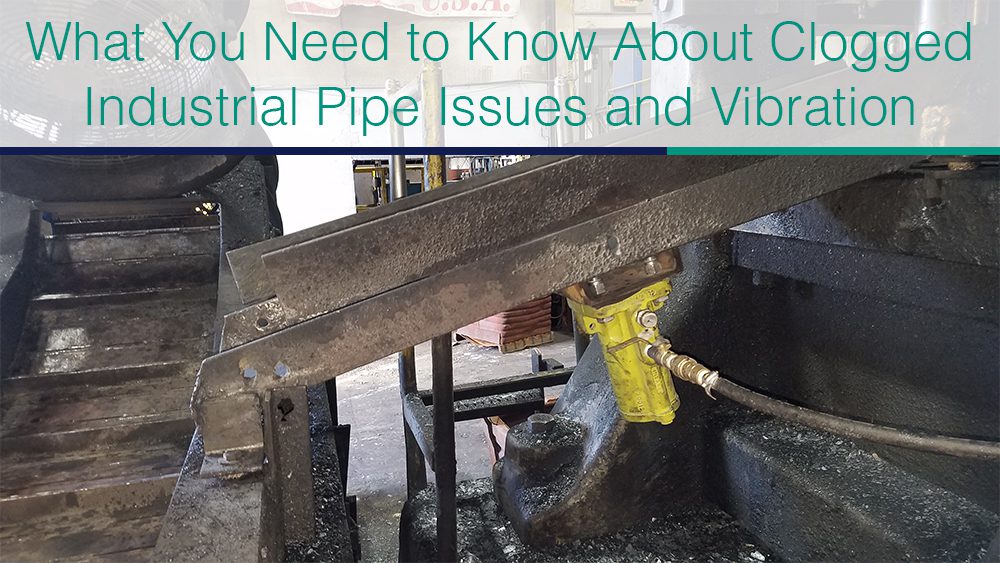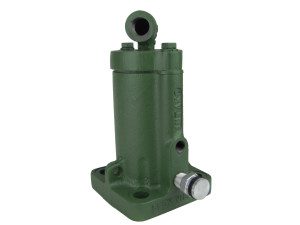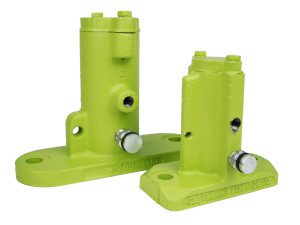Material flow issues are the worst. Not only are they a headache to deal with during production for the team out on the floor, but they may be costing you valuable time and money in the long run. The usual suspects for material flow hang-ups typically occur in bulk supply hoppers or industrial bins. But, what about those industrial pipes and chutes transferring materials throughout various stages of production?
Industrial vibration is not just for those usual suspects; it can be just as successful when applied to those transfer chutes and pipes! Not only does it get the job done, but it is economical and ultimately saves the integrity of your equipment and your team’s shoulders and backs.
Here is a real-world example.
A producer dealing with a wet clay material was experiencing material hang-ups in their aluminum pipes. The sticky and stubborn nature of the wet clay wasn’t flowing well out of the 6″ diameter vertically mounted pipe. Naturally, one would think gravity would do the hard work, but unfortunately, it was not doing the trick in this case. They resorted to knocking the aluminum pipes with a rubber mallet. (We don’t advise that this is a good idea)
That was until they discovered the power of industrial vibration, of course!
What factors determine the best industrial vibrator to use?
Their production required a pneumatic powered vibrator option that would produce linear force to address this issue. The diameter of the pipe, wall thickness, and material characteristics were the obvious factors to consider when finding the best vibrator option.
In most cases, material characteristics would be the biggest contributing factor to the decision-making process. Continuous vibration tends to pack sticky materials rather than promote free flow. Typically, sticky materials flow better with intermittent vibration using an option such as a SI Single Impact Air Knocker, which delivers a hammer-like vibration. This was the obvious first choice, but the other two factors, in this case, were the difference makers when choosing the best vibrator option.
The pipe was made of aluminum and was specially designed with a 1/8th inch wall thickness. Air Knockers deliver a high-impact, low-frequency vibration that could damage the pipe over time. There was concern that the pipe would not handle the blows due to its narrow wall thickness and overall OD, as these models can deliver up to 20 impacts per minute.
They turned to option #2: a continuous vibration method with lower force frequency.
Air Cushion Piston Vibrators provide non-impacting linear force at controllable frequencies determined by the amount of air pressure applied. Their frequencies usually fall within the 2,000-3,000 VPM (vibrations per minute) range for pipe and chute applications. It is a gentler vibration solution that maintains the pipe’s integrity in the long run. Another solid “plus” is the lower noise levels during operation.
An industrial vibrator that gets the job done and does not require ear protection during operation? You can chalk it up as a win-win.
Though they are rated for continuous duty, operational life out in the field can be extended using short bursts of vibration and adhering to regularly scheduled maintenance checks.
It was the option that best fits the bill in this instance. Did we mention it was a solution that cost them LESS THAN $700?
That surely beats costly downtime to rid the pipe of material stuck inside, and it saves their team’s physical wellbeing from swinging that mallet or hammer.
If you ask the pros, knocking the pipes with a mallet is never the best option. Sure, it is tempting because it is easily accessible, but the damage it causes to your equipment and your team is not worth it.
No two chute and pipe material flow applications are ever the same or cut and dry. You must consider the variables that decide your best option. That is the beauty of the industrial vibrator world, all applications are unique to some degree, and now and then, one comes along that challenges the norm.
Do you have a question about material flow issues in your pipes or chutes within your facility? We are here to help you!
Follow us:
Share this blog post:




